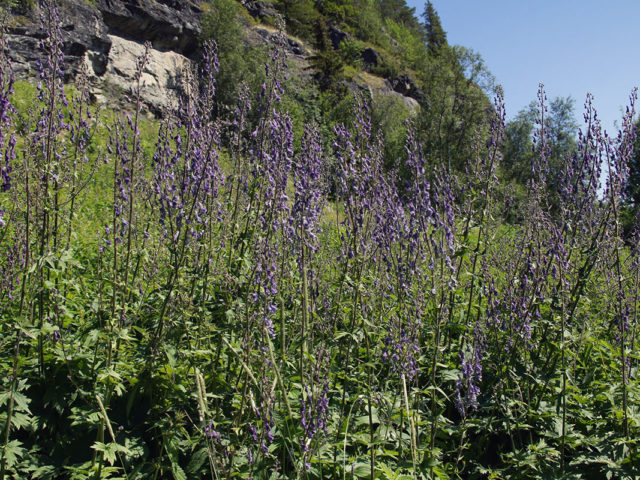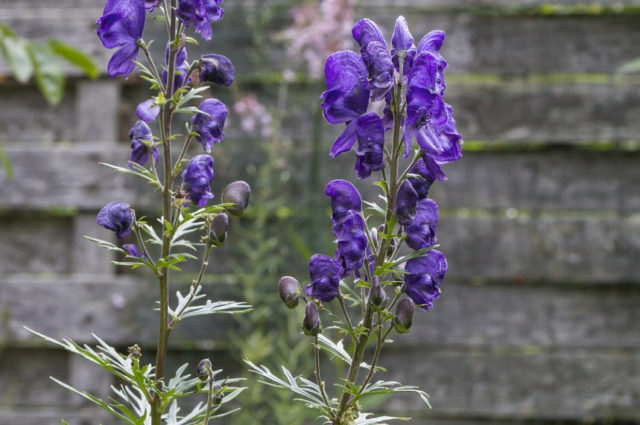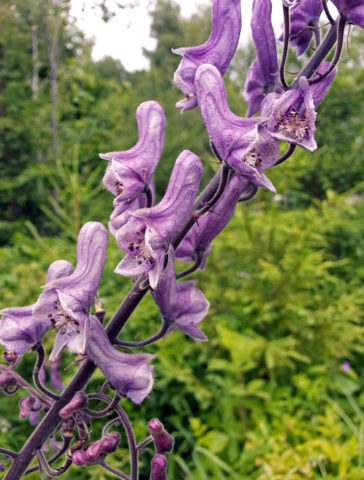Content
Aconite tall is a plant shrouded in many legends, one of which says that it owes its appearance to the three-headed Cerberus. After Hercules lured him out of the kingdom of Hades, purple saliva poured from the three jaws of the monster. A plant with both toxic and medicinal properties appeared in the places of its fall.
Description of the species
Aconite tall (Aconitum septentrionale), or Borets, is a perennial plant belonging to the Buttercup family. Its ribbed and slightly pubescent stem reaches a height of 65 to 250 cm. The leaves of aconite are high, cordate, divided, deep-fingered, with pubescence. Their length is 15 cm, width is 25 cm.
The plant forms an inflorescence in the form of a loose brush with gray-violet petals, irregular cylindrical shape with a spout. Aconite tall has another name - helmet. It is associated with the shape of the buds, similar to the helmet. The tops of the petals have grown together, and the lower ones are bent in the form of a visor. The inflorescences look very powerful and belligerent, which is supported by strong peduncles and shoots.
The roots of the plant are long, highly branching, with accrete lobes.
The flowering of high aconite continues from June to August, after which the fruits ripen, consisting of three leaflets with a large number of triangular seeds. They fall off in autumn and germinate in early spring.

The wrestler is a frost-resistant plant that can withstand temperatures from -40 ⁰С
Where and how it grows
Aconite tall prefers moist soils of meadows and forest edges. The plant can be found on river banks, in ravines and in subalpine mountain meadows.
The northern wrestler is widespread in the European part of the Russian Federation from the Karelian Territory to the Ural Mountains. In Western and Eastern Siberia, it grows in the forest and forest-tundra zone up to the Lena River.
The plant is often grown as an ornamental plant that grows rapidly. With improper agricultural technology, high aconite can sprout and spread throughout the territory on its own. It can often be seen on the site of old abandoned houses, uncultivated plots and along roads.
Healing properties
Aconite tall is considered a poisonous plant, since its chemical composition contains the alkaloid aconitine. In addition to toxic, it has a therapeutic effect due to the presence of nutrients in the composition:
- micro and macro elements;
- vitamins;
- tannins;
- fatty acids;
- flavonoids;
- starchy compounds;
- resins;
- sugars.
On the basis of high aconite, preparations are created that have medicinal properties:
- antibacterial;
- antipyretic;
- anti-inflammatory;
- pain relievers;
- hemostatic;
- astringent;
- diuretic;
- calming;
- antispasmodic.
In official medicine, preparations based on high aconite have long been used only as a means for external use. In 1989, the drug "Allapinin", which contains an alkaloid from a plant, was approved for wide clinical use. The drug is used to treat heart rhythm disorders.
Application in traditional medicine
Aconite is high - a poisonous plant, therefore, traditional healers who prepare medicines based on them subject the raw materials to complex and lengthy processing (they are boiled for a long time, changing the water several times).
For the treatment of rheumatism, a tincture of high aconite roots is used, which is prepared from 100 g of raw materials and 1 liter of vodka.After 3 days, as soon as it acquires the color of strong tea, you can start rubbing in the liquid, using no more than 1 tsp at a time. facilities. It is recommended to follow the sequence - rub only one arm or leg a day, then cover it with a warm cloth for 2 hours.

In folk medicine, aconite is used as an immunomodulatory agent.
Aconite root ointment is used for radiculitis. For its preparation, 5 g of crushed raw materials are poured in 200 ml of olive oil. After thorough mixing, the agent is heated in a water bath for 30 minutes. The resulting ointment is rubbed into the diseased areas of the body with light circular movements.
In folk medicine, high aconite tincture is used in the treatment of cancer. Therapy is carried out in courses according to a rigid scheme, starting with a minimum amount (1 drop per dose), gradually increasing to 10, and again reducing to a minimum. After the course, take a break for a month and repeat again.
Limitations and contraindications
The high content of poison in the composition of high aconite requires caution in the use of funds prepared on its basis.
Contraindications for use include:
- allergic reactions to the plant;
- pregnancy and lactation;
- hypertension;
- age up to 18 years.
To avoid undesirable reactions, you should not combine drugs based on high aconite with alcohol, caffeine, menthol, nicotine, citric acid or glucose.
Poisoning symptoms
The action of the poison, which is high in aconite, is determined by its dose and the degree of effect on the center of the vagus nerve and on the conductivity in peripheral neurons. The first symptoms of poisoning appear 30-60 minutes after ingestion. The duration of their action is up to 24-30 hours.
Symptoms of plant toxin damage:
- The appearance of a burning sensation in the mouth.
- Increased salivation and salivation.
- Rapid development of nausea, vomiting and diarrhea.
- Violation of cardiac activity - hypotension, tachyarrhythmia, bradycardia.
- Decreased sensitivity, lips and limbs go numb.
- Deterioration of vision, vision of everything around in green.
- The appearance of a burning sensation, crawling, muscle weakness.

All parts of aconite are used as a medicine.
Taking 5-6 g of high aconite root can lead to impaired consciousness, seizures, partial paralysis and epileptic seizures. A dose of 5-18 g of plant root can be fatal for an adult.
First aid
If there are signs of high aconite poisoning, it is necessary to call an ambulance and provide first aid to the victim:
- Give him about 1 liter of water to drink and, by pressing on the root of the tongue, induce vomiting.
- Repeat several times until the stomach is completely empty, to "clear water".
- As a saline laxative, dissolve 30 g of magnesia sulfate in half a glass of water and give to drink.
- If there is no laxative, you can give an enema by dissolving a teaspoon of shavings from baby or laundry soap in 1 glass of warm water.
- Drink 20-30 g of activated charcoal mixed in warm water.
- Take a diuretic (1 tablet of furosemide, veroshpiron).
- Offer the victim to drink strong tea or coffee.
- Cover it with a blanket, cover with heating pads.
Before the arrival of the ambulance, you need to observe the poisoned person, monitor his pulse, respiration and blood pressure. If necessary, start resuscitation measures.
Northern aconite as a garden plant
Outwardly spectacular high aconite refers to frost-resistant perennials and is used by gardeners as an ornamental plant, despite its toxicity.It can be grown in shaded areas where the soil is moist but well-drained.
Aconite tall is planted in early spring or autumn. The pit is made spacious for the roots of the fighter, complex mineral fertilizer is added there. The root collar should be 2 cm buried in the ground. A distance of 30 cm is left between the bushes.
Plant care is simple - loosening, weeding, watering in dry weather.
Aconite high can be propagated by seeds, for which they are stratified first in warmth (30 days), and then in the cold (three months). After the seedlings grow up, they are dived, and in the fall they are planted in a permanent place. The first flowering of the plant will come after 3 years.
Aconite high is placed in single and group plantings. Due to the long flowering and beautiful rugged foliage, it remains decorative for a long time and serves as a decoration for the garden.

The wrestler reproduces exclusively by seeds
Conclusion
With careful handling and adherence to the dosage, aconite high can be beneficial in the treatment of a number of diseases. It is necessary to observe caution when handling the plant, take timely measures to provide assistance in case of poisoning and prevent children from contact with it.








